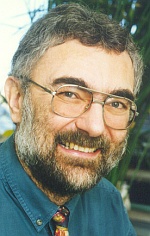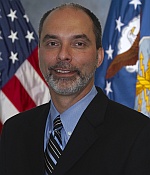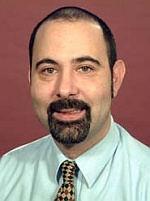Call for Papers
Important Dates
Keynote Speakers
Special Sessions
Paper Submission
Technical Program
Registration
Venue
Travel Information
Accommodation
Committees
Sponsors
ELMAR History
KEYNOTE SPEAKERS
|
Telepresence, the ’World-Wide Wait’ and ’Green’ Radios... Prof. Lajos Hanzo School of Electronics and Computer Science |
Non-rigid, non-rigid, non-rigid world Dr. Michael M. Bronstein Department of Computer Science |
|
|
Got GPS? The Navigation Gap Dr. Mikel M. Miller Munitions Directorate |
|
3D reconstruction and stenosis quantification Dr. Panos Liatsis Information and Biomedical Engineering Centre |
Telepresence, the ’World-Wide Wait’ and ’Green’ Radios...
Prof. Lajos Hanzo
School of Electronics and Computer Science
University of Southampton
United Kingdom
Abstract:
Since Marconi demonstrated the feasibility of radio transmissions, researchers have endeavoured to fulfill the dream of flawless wireless multimedia telecommunications, creating the impression of tele-presence - at the touch of a dialling key and with the aid of the future wireless solutions to be discussed in the lecture.
Commencing with a light-hearted historical perspective on the generations of wireless systems, Shannon’s lessons are contrasted with the practical constraints imposed on state-of-the-art multimedia communicators. In the face of adverse wireless channel conditions it is unrealistic to expect that any fixed-mode wireless system remains capable of maintaining a constant quality-of-service. This motivates the design of cutting-edge near-instantaneously adaptive modulation and coding aided multi-media transceivers, which offer capabilities beyond those of conventional systems. Indeed, they facilitated in excess of a 1000-fold bit-rate increase since the conception of GSM...
However, at what price? Is this 1000-fold bit-rate increase sufficient anyway to support the impression of flawless tele-presence with its sense of joy, wonder and ambiance? Or are we about to be further frustrated by the ’World-Wide Wait’ (WWW) experienced at places of high
tele-traffic density?
A glimpse of the recent advances in Multiple-Input Multiple-Output (MIMO) techniques employing adaptive antenna arrays and their virtual-MIMO counterparts created by cooperating single-antenna-assisted handsets reveals that they are capable of circumventing the ’world wide wait’ in the emerging wireless Internet, while facilitating sustainable, ’green’ communications...
About the Keynote Speaker:
Lajos Hanzo received his degree in electronics from the Technical University of Budapest in 1976, his doctorate in 1983, defended his DSC Candidate thesis in 1992 and his Doctor of Sciences (DSc) degree in 2004. He is a Fellow of the Royal Academy of Engineering (FREng). During his career in telecommunications he has held various research and academic posts in Hungary, Germany and the UK. Since 1986 he has been with the School of ECS, University of Southampton, UK, where holds the Chair in Telecommunications. He co-authored 17 Wiley - IEEE Press books totalling 10 000 pages on mobile radio communications, published in excess of 900 research papers and acted as General Chair/TPC Chair and keynote speaker of major IEEE Conferences, such as WCNC’2006, WCNC’2009, Mobimedia’2008, Mobimedia’2009, CNSR’2009, SSP’2009, VTC’2010Sring, VTC’2010Fall, VTC’2011 etc. He has also been awarded a number of distinctions, such as the IEEE Wireless Technical Committee Achievement Award, the IET’s Sir Monti Finniston Award across all disciplines and HTE’s 60th anniversary Jubilee Medal. He received Best Paper Awards for example at WCNC’2007 and ICC’2009. He heads an academic research team, working on a range of research projects in the field of wireless multimedia communications sponsored by industry, the Engineering and Physical Sciences Research Council (EPSRC) UK, the European Commission and the Mobile Virtual Centre of Excellence (VCE), UK. He is an enthusiastic supporter of industrial and academic liaison, acts as a non-executive director of the VCE and he offers a range of industrial courses. Lajos is an IEEE Distinguished Lecturer as well as Governor of both the IEEE Communications as well as of the Vehicular Technology Society and a Fellow of both the IET and the IEEE. He is the Editor-in-Chief of the IEEE Press. For further information on research in progress and associated publications please refer to: www-mobile.ecs.soton.ac.uk
Keynote Speaker's web-page:
http://www-mobile.ecs.soton.ac.uk
Non-rigid, non-rigid, non-rigid world
Dr. Michael M. Bronstein
Department of Computer Science
Technion - Israel Institute of Technology
Haifa, Israel
Abstract:
Non-rigid shapes are ubiquitous in the world surrounding us, at all levels from nano to macro. The need to study such objects and model their behavior arises in a wide spectrum of applications. In this talk, we will focus on two archetype problems in shape analysis: similarity and correspondence. We will approach the non-rigid world from the perspective of metric geometry. We will model shapes as metric spaces and pose the similarity and correspondence problems as the problem of comparison of metric spaces. This model will allow us to obtain new methods as well as get new insights into classical methods for shape analysis. As examples of applications, we will use problems from the fields of computer vision, pattern recognition, and computer graphics.
About the Keynote Speaker:
Michael Bronstein received his Ph.D. from the Department of Computer Science, Technion (Israel Institute of Technology) in 2007. Following his graduation, Michael spent two years in the USA as a co-founder and VP in a Silicon Valley start-up company leading a team of scientists and engineers developing Internet-scale computer vision applications. He also held a visiting appointment at Stanford university in 2009. He is currently with the Department of Computer Science, Technion. Michael has published a book and over 50 papers in leading journal and conferences, mainly on the topics of non-rigid shape analysis, computer vision, and image processing. In 2008 and 2009, he was the co-chair of the Workshop on Non-rigid shapes and deformable image alignment (NORDIA).
Keynote Speaker's web-page:
http://www.cs.technion.ac.il/~mbron/
Dr. Mikel M. Miller
Munitions Directorate
Air Force Research Laboratory
Eglin Air Force Base
Florida, USA
Abstract:
Over the past couple of decades, there have been a number of navigation trends that have driven the desire to improve our ability to navigate in all environments. Previously, the primary desire was to navigate single, stand-alone systems (such as a car), but now, the desire is increasingly to have simultaneous navigation awareness of multiple interdependent systems (such as a traffic notification system in a car). Previously, navigation capability was not always counted on, but increasingly navigation is considered to be an assumed infrastructure (like knowing the lights will come on when you turn on the light switch). Previously, navigation accuracy of 5-10 m seemed almost extravagant when other worldwide navigation options prior to GPS had accuracies more on the order of 1-2 km. Now, there are many applications that require meter or sub-meter level accuracy (such as precision agriculture). Previously, due to cost, power, and size constraints, it was generally only feasible to know where the "big things" are (such as airplanes). Now, navigation is desired on more and more, smaller and smaller objects (such as cell phones).
While GPS has been the driving factor behind most of these trends, there are limitations to GPS that have become more evident over time as we have increasingly come to rely on navigation. The shortfalls in GPS could be called the "navigation gap." Recent advancements in high-sensitivity GPS have helped to decrease the size of this gap, but there still remains a gap where availability, accuracy, or reliability of GPS by itself is not sufficient for many applications. Ironically, it is in just such urban/indoor locations where many people spend most of their time. (In fact, odds are that you would have a hard time obtaining a high accuracy GPS fix wherever you are reading this paper!)
Summarizing, it would be desirable to develop a navigation system that (a) supports an indefinite mission duration, (b) supports real-time 3D location performance, (c) supports localization in urban environments and inside residential and most commercial buildings, (d) supports operation in an unknown (unmapped) or sparsely known (partially mapped) environment, (e) supports localization from the power-off condition and requires no separate starting location initialization of the user equipment, (f) supports individual isolated user terminals, (g) shall be able to re-acquire the navigation capability after a temporary loss, (h) is low-cost and low-weight, (i) does not require user motion to work, (j) shall have a level of integrity (assurance), accuracy, availability and continuity of service consistent with the tactical mission requirements.
This talk focuses on the latest technology trends for navigating in difficult urban, indoor, and underground environments where typical Global Positioning System (GPS) receivers do not function. Several of the latest alternative navigation (Alt-Nav) technologies will be presented. The challenge is to tightly integrate these technologies to achieve navigation performance similar to that is achieved in today's GPS integrations. An Alt-Nav integration vision for the future is given with some example configurations that improve overall navigation system robustness.
About the Keynote Speaker:
Dr. Mikel Miller is the Assistant to the Chief Scientist, Munitions Directorate, Air Force Research Laboratory, Eglin Air Force Base, Florida. He received his Ph.D. in Electrical Engineering from the Air Force Institute of Technology (AFIT), Wright-Patterson Air Force Base, Ohio, in 1998. Since 1986, he has focused on navigation system research and development (R&D) related to Global Positioning System (GPS), GPS/Inertial Navigation System (INS) integrations, alternative navigation techniques including bio-inspired navigation and signals of opportunity-based navigation, autonomous vehicle navigation and control, and multi-sensor fusion. He is currently responsible for directing the Directorate's scientific/technical in-house and contracted R&D projects advancing weapon development technology. He is also an Adjunct Professor of Electrical Engineering at AFIT and Miami University of Ohio. Dr. Miller is President of the Institute of Navigation (Fellow), Chairman of the Joint Service Data Exchange (JSDE), and a member of the Royal Institute of Navigation (Fellow), IEEE, and American Institute of Aeronautics and Astronautics (AIAA). The Iowa native has authored or co-authored over 50 journal articles, technical papers, and documents.
Keynote Speaker's web-page:
http://www.eglin.af.mil/units/afrlmunitionsdirectorate/
3D reconstruction and stenosis quantification in CT angiograms
Dr. Panos Liatsis
Information and Biomedical Engineering Centre
School of Engineering and Mathematical Sciences
City University London
United Kingdom
Abstract:
In this presentation, a novel framework for the segmentation and quantification of stenosed coronary arteries in 3D contrast enhanced computed tomography angiography (CTA) is presented. There is currently no commercially available software which permits the fully automated detection and assessment of atherosclerotic stenoses in coronary arteries. Therefore, in clinical practice, the radiologist has to make a detailed visual evaluation, segment by segment, which is a labour intensive and time consuming task, as well as producing subjective results. A novel framework is proposed here where the main branches of the coronary arteries are firstly extracted from the volume datasets by using a localized region-based level sets framework. This is followed by the removal of calcified voxels through a post processing step. The centrelines of the coronaries are extracted using a mesh contraction algorithm. Finally, two descriptors, namely circularity and convex hull deficiency of the cross sections, at specific locations along the coronary arteries are used to automatically detect and identify the presence of calcified stenoses.
About the Keynote Speaker:
Panos Liatsis is a Reader in Sensor Systems and heads the Information Engineering and Medical Imaging group in the School of Engineering and Mathematical Sciences at City University. He received his first degree (Diploma) in Electrical Engineering from the University of Thrace and his PhD degree from the Control Systems Centre at the University of Manchester. His research focuses in the areas of X-ray/CT angiography, Electrical Impedance Tomography, Neural Networks and Evolutionary Optimisation. His work is funded by the UK Engineering and Physical Sciences Research Council, Framework 7 of the European Comission, the Royal Society as well as directly from UK industry and NHS organizations. Panos published over 100 research contributions in high-impact factor journals, books and international conference proceedings, and is on the International Programme Committee of major international conferences in image and signal processing.
Keynote Speaker's web-page:
http://www.city.ac.uk/sems/our%20staff/eeie/liatsis.html


